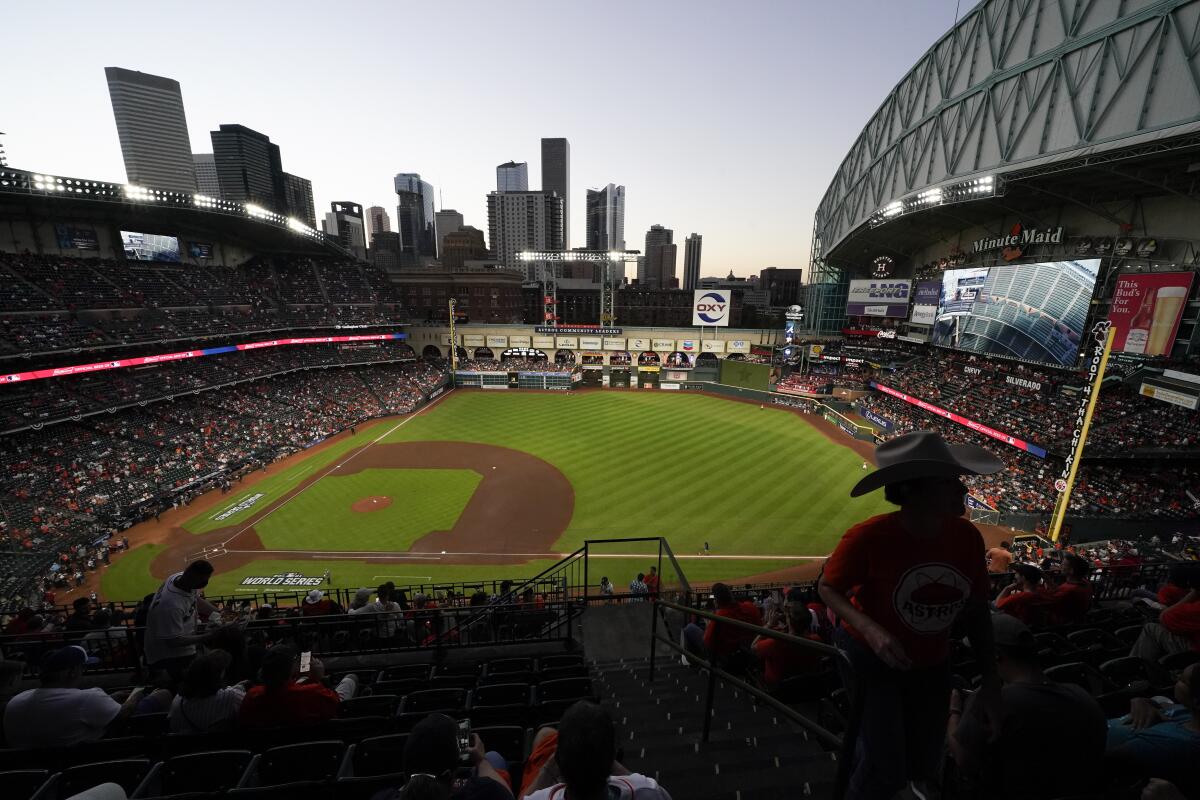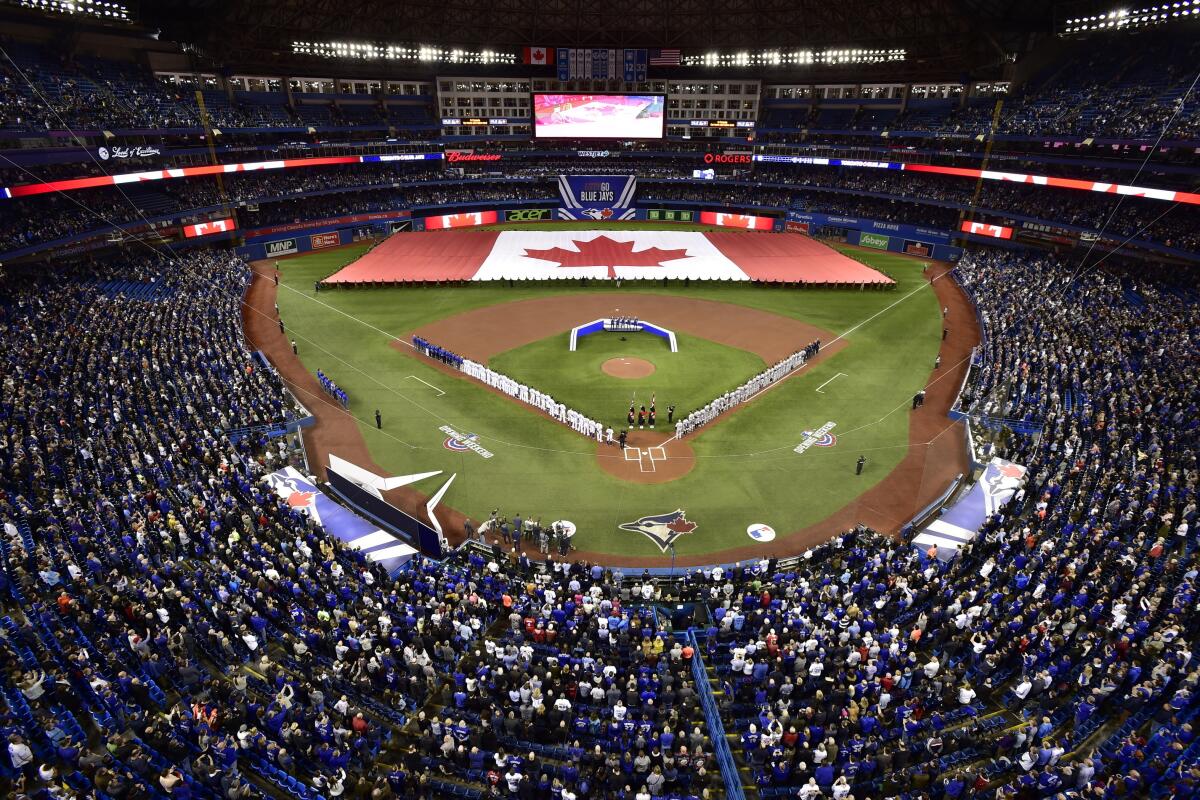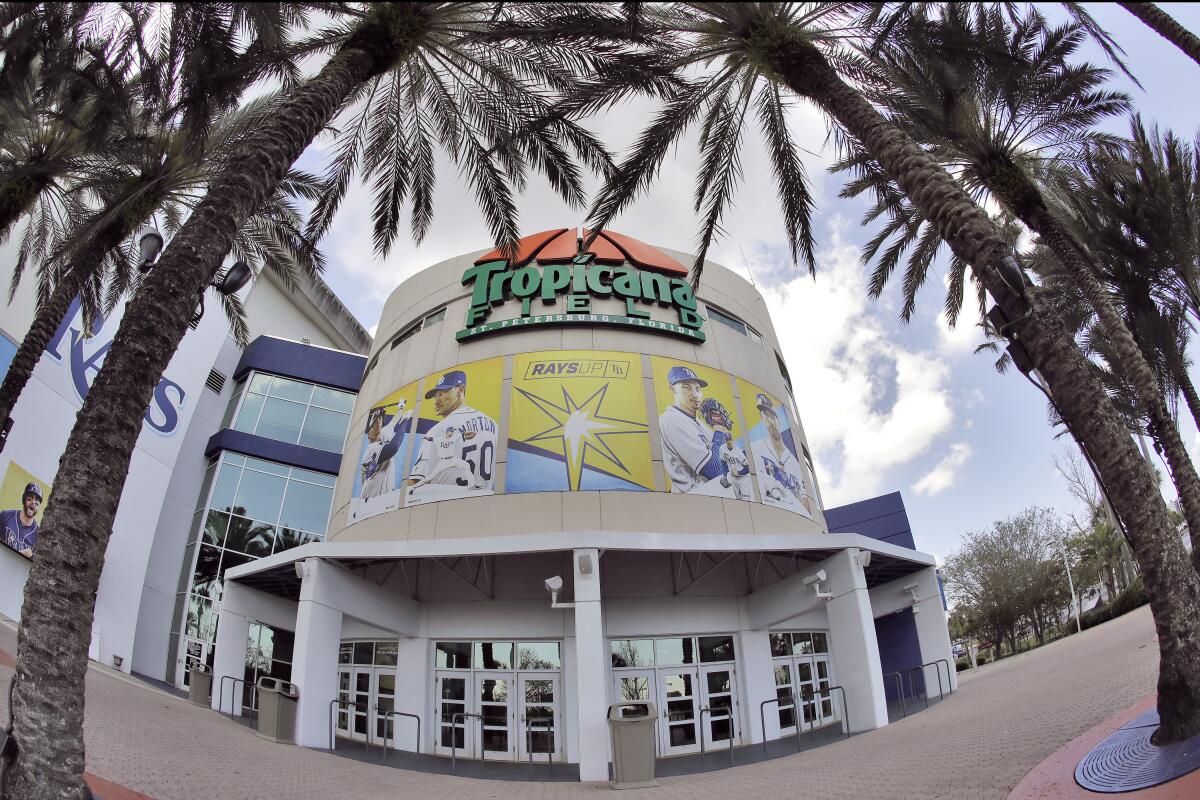Yes, you should plan a summer trip around baseball. A guide to all 30 MLB ballparks
- Share via
Some MLB ballparks have been around for more than a century.
Some have been around for just a few years.
Some have been around for a relatively short period of time but were designed to look and feel like they’ve been around much longer.
Dodger Stadium is a distinctly wonderful place to watch a baseball game, but a most difficult place to attend a baseball game.
And some might not be MLB ballparks in the not-so-distant future.
But all 30 stadiums have their own unique fan traditions, hidden secrets and special features.
And all 30 are worth a visit.
The Angels used to light the ‘Big A’ at Angel Stadium after victories. That’s changed. It’s time to go back to the way it used to be.
Whether it’s on your bucket list to take in a game at every site or you just want to soak in the atmosphere at a handful of specific fields, here’s some information to help start planning your trip.
American Family Field

Year opened: 2001
Root for your favorite oversized encased meat character during the famous sausage races and join fellow fans in a rousing rendition of the “Beer Barrel Polka” during the seventh-inning stretch. And don’t forget to pose for a photo next to the statue of longtime Brewers broadcaster Bob Ueker, which is “just a bit outside” the stadium.
Angel Stadium

Year opened: 1966
Come to the “Big A” and check out the actual big A, a 230-foot structure topped by a light-up halo, in the parking lot and visible from three nearby freeways. Watch for the Rally Monkey, made famous during the Angels’ World Series run in 2002, to jump around on the video screen — but only if the home team is down by four runs or less late in the game.
Busch Stadium

Year Opened: 2006
The third venue in the city’s history to be known as Busch Stadium, this one offers views of the St. Louis skyline and the famous Gateway Arch from almost any seat. And no matter where your seat might be, you might want to enter the ballpark through Gate 3, where you will pass under a replica of the nearby Eads Bridge.
Chase Field

Year opened: 1998
What’s the best way to enjoy baseball in the desert? In a swimming pool in right-center field, of course (just ask the Dodgers). The Crèmily Pool Suite might cost thousands to rent (rates started at $4,750 a game in 2017), but that will get you and 34 friends the coolest seat in the house — plus a Diamondbacks pool towel to keep as a souvenir.
Citi Field

Year opened: 2009
Come for the orange foul poles — the only ones in MLB that are not yellow. Stay for the faux fruit — the 18-foot Home Run Apple rises from behind the center-field wall whenever a Mets player hits a dinger. A smaller version, brought over from the team’s former home, Shea Stadium, resides outside the front entrance to the current ballpark.
Citizens Bank Park

Year opened: 2004
The late Tug McGraw is one of more than 40 former Phillies greats honored on the Wall of Fame at the Bank. The pitcher who recorded the final out of the team’s 1980 World Series championship is, however, likely the only former player whose ashes have been spread on the pitcher’s mound (thanks to his country singer son Tim McGraw).
Comerica Park

Year opened: 2000
A 50-foot Ferris wheel with cars that look like giant baseballs sits along the third base side of the ballpark. A fountain that sits behind the centerfield wall produces “liquid fireworks” (a light show synchronized with music) after a Tigers home run or victory. And lots of larger-than-life tiger statues throughout the joint add to the festive atmosphere.
Coors Field

Year opened: 1995
Try a seat in the 20th row of the upper deck, where you can enjoy the game at exactly one mile above sea level. Not high enough for you? Then climb up to the Rooftop in the upper right-field deck, where any ticketed fan can enjoy spectacular views of downtown Denver and the Front Range mountains (and, of course, the on-field action).
Dodger Stadium

Year opened: 1962
Both old school and recently renovated, Dodger Stadium remains a prime destination for baseball fans who don’t mind a teeny, tiny bit of freeway traffic (a proposed gondola from Union Station may eventually provide relief). Dodger Dogs and the endless clever song choices of organist Dieter Ruehle are among the highlights of a visit to Chavez Ravine.
Fenway Park

Year opened: 1912
It is the oldest active MLB ballpark. It is listed on the National Register of Historic Places. It’s home to the Green Monster, the Triangle and Pesky’s Pole. When you go to the legendary stadium, perhaps sit in the lone red seat in the right-field bleachers (Section 42, Row 37, Seat 21), marking the spot of Ted Williams’ 502-foot home run on June 9, 1946.
Globe Life Field

Year opened: 2020
The ballpark is only a few years old, but there are plenty of subtle nods to Rangers history. The field’s dimensions were inspired by important numbers in team lore (for example, the left-field line is 329 feet, a tribute to Adrian Beltre‘s jersey No. 29). Also, home plate was brought over from Globe Life Park, which served as the Rangers’ home from 1994 to 2019.
Great American Ball Park

Year opened: 2003
Twin smokestacks in the right-center field area — an homage to the steamboats once a common sight on the Ohio River — shoot out celebratory flames after a strikeout and fireworks after a home run or victory. The distance to center field is 404 feet, exactly the same as it was at Riverfront Stadium/Cinergy Field, the Reds’ home from 1970 to 2002.
Guaranteed Rate Field

Year opened: 1991
If you value history over comfort, you might want to sit in the old blue seat in the left field stands (Section 159, Row 7, Seat 4) or the blue one in the right field stands (Section 101, Row 1, Seat 13). Unlike the green seats around them, those two seats have not been replaced since they were the landing spots for a pair of home runs during Game 2 of the 2005 World Series.
Kauffman Stadium

Year opened: 1973
The sixth-oldest ballpark in the majors is home to the Water Spectacular, which lives up to its name. It’s a series of fountains along 320 feet of the outfield wall that utilizes 600 nozzles and a half-million gallons of water to produce more than 150 water displays. Enjoy it while you can — the team’s lease is up in 2030 and owner John Sherman wants a new stadium.
loanDepot Park

Year opened: 2012
The swimming pool area is gone. So are the fish tanks behind homeplate. And the garish “home run” statue has been banished to outside the stadium. But there are still plenty of fun reasons to come to Miami’s MLB ballpark, like its bobblehead museum, multicolored walkways and, of course, a Marlins game.
Minute Maid Park

Year opened: 2000
In a nod to Houston’s historic Union Station, which is now the west portion of the stadium, a replica of a 19th century train runs along an 800-foot track that is 90 feet off the ground behind left field whenever the Astros take the field at the start of a game or score a run. Its cargo is a bunch of oversized, fake oranges, in honor of the juice made by the ballpark’s corporate sponsor.
Nationals Park

Year opened: 2008
The cherry blossoms behind left field are a nice touch. The views of the U.S. Capitol and Washington Monument from certain seats are cool too. But the main (non-baseball) attraction is the fourth-inning Presidents Race, featuring oversized versions of George Washington, Thomas Jefferson, Abraham Lincoln and fan favorite Theodore Roosevelt.
Oakland Coliseum

Year opened: 1966 (first Athletics game 1968)
It’s one of MLB’s oldest active stadiums but probably won’t be for long. With the Athletics’ proposed move to Las Vegas all but finalized, baseball fans with a sense for history might want to check out the venue once referred to by New York Times as “a bland, charmless concrete monstrosity” while they still have the chance.
Oracle Park

Year opened: 2000
One of the crown jewels of MLB ballparks and a truly festive atmosphere. A 9-foot statue of Willie Mays stands at the entrance. An 80-foot, light-up Coke bottle that doubles as a playground and a 25x30-foot baseball glove loom beyond the outfield, as does McCovey Cove and the fans in boats hoping to retrieve a “splash hit” home run ball blasted into the bay by a Giants player.
Oriole Park at Camden Yards

Year opened: 1992
The stadium that inspired a wave of retro-style ballparks across the league was built just two blocks from the birthplace of Babe Ruth, who never played for the Orioles but is immortalized with a bronze statue outside the venue. The former B&O Railroad warehouse stands tall beyond right field, and the area between the two buildings, Eutaw Street, is host to many festive activities on game days.
Petco Park

Year opened: 2004
The stadium was built around the famous Western Metal Supply Building, which was built in 1909 and declared a San Diego historic landmark in 1978. The building serves as the left foul pole, at 336 feet from home plate, and fans with tickets to the game are free to watch the action from the former warehouse’s balconies and rooftop.
PNC Park

Year opened: 2001
The Pirates nearly doubled the size of their scoreboard’s video display screen in 2023, but thankfully did so without obstructing any of the stadium’s spectacular view of the Pittsburgh skyline and Allegheny River. Maybe you’ll get to witness a home run blasted into that river, although the odds are against it. As of May 2023, it had only happened 68 times since the park opened.
Progressive Field

Year opened: 1994
Want to feel really immersed in a baseball game? Try the bullpen seats in center field, where you can enjoy an unobstructed view of the game action and scoreboard in front of you while getting to experience the sights and sounds of relief pitchers warming up in the stadium’s stacked bullpens directly behind you.
Rogers Centre

Year opened: 1989
The first retractable roof in an MLB ballpark weighs 11,000 tons and spans 339,343 square feet. It initially took at least 40 minutes to open or close but that time has been cut in half after renovations. Need a place to stay while in town for a game? The Toronto Marriott City Centre Hotel is located inside the ballpark, with 70 rooms that overlook the field.
T-Mobile Park

Year opened: 1999
The stadium area known as The ’Pen offers an up-close look at the relief pitchers as they warm up. While there, you might want to stop by Edgar’s Taco Shack to try some of the ballpark’s famous chapulines — aka toasted grasshoppers. The tasty treats, also available at Edgar’s Cantina in Section 212, are high in protein with no fat, carbs or gluten.
Target Field

Year opened: 2010
“Minnie & Paul” — the beloved characters featured in a 39x46-foot sign behind the center-field stands — received an upgrade prior to the 2023 season, with the duo now able to mechanically shake hands following a Twins home run. Also, a giant, light-up baseball medallion now sits on top of the right-field tower and rotates around the club’s Twin Cities logo.
Tropicana Field

Year opened: 1990
Visit the Trop, touch a Ray. OK, you probably should keep your hands off the Tampa Bay players — but stop by the 35-foot, 10,000-gallon Touch Tank just beyond the right-center field fence and tickle the wings of the cownose stingrays that live there (they won’t sting). The stadium’s roof, the only one in MLB that is not retractable, has been known to interfere with balls in play from time to time.
Truist Park

Year opened: 2017
The team’s rich history is celebrated in the outdoor Monument Garden, which includes a statue of Hank Aaron that stands in front of a sculpture made of 755 bats (arranged to form that number in honor of Aaron’s career home run total) and behind a natural rock waterfall. Another waterfall can be found in center field, where water shoots 50 feet in the air after a Braves home run or win.
Wrigley Field

Year opened: 1914
Check out the red marquee above the main entrance. And the ivy-covered, brick outfield walls. And the clock and manually operated out-of-town scoreboard over the right-field bleachers. After a Cubs win, watch the “W” flag as it’s raised over the scoreboard and join fellow fans for a rousing rendition of “Go, Cubs, Go!” So much tradition. So many iconic features. Makes sense for a place that’s been around for more than a century.
Yankee Stadium

Year opened: 2009
Located across the street from the original, now-demolished Yankee Stadium (where the park complex Heritage Field now stands), the modern venue was designed to resemble the historic one in many ways, including the look of the exterior, the layout of the seats inside and replicas of the old site’s signature frieze along the top of the building. The organization’s storied history also is celebrated in the Great Hall and Monument Park.






















